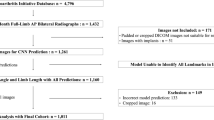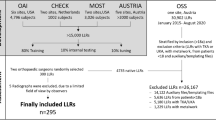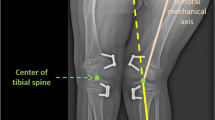Abstract
Purpose
Delayed diagnosis of syndesmosis instability can lead to significant morbidity and accelerated arthritic change in the ankle joint. Weight-bearing computed tomography (WBCT) has shown promising potential for early and reliable detection of isolated syndesmotic instability using 3D volumetric measurements. While these measurements have been reported to be highly accurate, they are also experience-dependent, time-consuming, and need a particular 3D measurement software tool that leads the clinicians to still show more interest in the conventional diagnostic methods for syndesmotic instability. The purpose of this study was to increase accuracy, accelerate analysis time, and reduce interobserver bias by automating 3D volume assessment of syndesmosis anatomy using WBCT scans.
Methods
A retrospective study was conducted using previously collected WBCT scans of patients with unilateral syndesmotic instability. One-hundred and forty-four bilateral ankle WBCT scans were evaluated (48 unstable, 96 control). We developed three deep learning models for analyzing WBCT scans to recognize syndesmosis instability. These three models included two state-of-the-art models (Model 1—3D Convolutional Neural Network [CNN], and Model 2—CNN with long short-term memory [LSTM]), and a new model (Model 3—differential CNN LSTM) that we introduced in this study.
Results
Model 1 failed to analyze the WBCT scans (F1 score = 0). Model 2 only misclassified two cases (F1 score = 0.80). Model 3 outperformed Model 2 and achieved a nearly perfect performance, misclassifying only one case (F1 score = 0.91) in the control group as unstable while being faster than Model 2.
Conclusions
In this study, a deep learning model for 3D WBCT syndesmosis assessment was developed that achieved very high accuracy and accelerated analytics. This deep learning model shows promise for use by clinicians to improve diagnostic accuracy, reduce measurement bias, and save both time and expenditure for the healthcare system.
Level of evidence
II.





Similar content being viewed by others
References
Abdelaziz ME, Hagemeijer N, Guss D, El-Hawary A, El-Mowafi H, DiGiovanni CW (2019) Evaluation of syndesmosis reduction on CT scan. Int Foot Ankle 40:1087–1093
Ashkani Esfahani S, Bhimani R, Lubberts B, Kerkhoffs GM, Waryasz G, DiGiovanni CW, Guss D (2021) Volume measurements on weightbearing computed tomography can detect subtle syndesmotic instability. J Orthop Res 40(2):460–467
Bekerom M (2011) Diagnosing syndesmotic instability in ankle fractures. World J Orthop 2(7):51–56
Bekerom M, De Leeuw P, van Dijk N (2009) Delayed operative treatment of syndesmotic instability. Injury 40(11):1137–1142
Bhimani R, Ashkani Esfahani S, Lubberts B, Guss D, Hagemeijer N, Waryasz G, DiGiovanni CW (2020) Utility of volumetric measurement via weight-bearing computed tomography scan to diagnose syndesmotic instability. Foot Ankle Int Foot Ankle Int 41:859–865
Borjali A, Chen A, Muratoglu O, Varadarajan KM (2020) Detecting mechanical loosening of total hip arthroplasty using deep convolutional neural network. Orthop Proc 102-B:133
Borjali A, Chen AF, Bedair HS, Melnic CM, Muratoglu OK, Morid MA, Varadarajan KM (2021) Comparing the performance of a deep Convolutional Neural Network with orthopaedic surgeons on the identification of total hip prosthesis design from plain radiographs. Med Phys 48(5):2327–2336
Borjali A, Chen AF, Muratoglu OK, Morid MA, Varadarajan KM (2020) Detecting total hip replacement prosthesis design on plain radiographs using deep convolutional neural network. J Orthop Res 38(7):1465–1471
Borjali A, Chen AF, Muratoglu OK, Morid MA, Varadarajan KM (2020) Deep learning in orthopedics: how do we build trust in the machine? Healthc Transform heat.2019.0006
Borjali A, Magnéli M, Shin D, Malchau H, Muratoglu OK, Varadarajan KM (2021) Natural language processing with deep learning for medical adverse event detection from free-text medical narratives: a case study of detecting total hip replacement dislocation. Comput Biol Med Pergamon 129:104140. https://doi.org/10.1016/j.compbiomed.2020.104140
Burssens A, Vermue H, Barg A, Krähenbühl N, Victor J, Buedts K (2018) Templating of syndesmotic ankle lesions by use of 3D analysis in weightbearing and nonweightbearing CT. Foot Ankle Int 39:1487–1496
Deng J, Dong W, Socher R, Li L-J, Li K, Fei-Fei L (2009) Imagenet: a large-scale hierarchical image database. 2009 IEEE conference on computer vision and pattern recognition, pp. 248–255
Hagemeijer NC, Chang SH, Abdelaziz ME, Casey JC, Waryasz GR, Guss D, DiGiovanni CW (2019) Range of normal and abnormal syndesmotic measurements using weightbearing CT. Foot Ankle Int 40:1430–1437
Kellett JJ, Lovell GA, Eriksen DA, Sampson MJ (2018) Diagnostic imaging of ankle syndesmosis injuries: a general review. J Med Imaging Radiat Oncol 62(2):159–168
Malhotra K, Welck M, Cullen N, Singh D, Goldberg AJ (2019) The effects of weight bearing on the distal tibiofibular syndesmosis: a study comparing weight bearing-CT with conventional CT. Foot Ankle Surg 25:511–516
Merkely G, Borjali A, Zgoda M, Farina EM, Görtz S, Muratoglu O, Lattermann C, Varadarajan KM (2021) Improved diagnosis of tibiofemoral cartilage defects on MRI images using deep learning. J Cartil Jt Preserv 1(2):100009. https://doi.org/10.1016/j.jcjp.2021.100009
Morid MA, Borjali A, Del Fiol G (2021) A scoping review of transfer learning research on medical image analysis using ImageNet. Comput Biol Med 128:104115. https://doi.org/10.1016/j.compbiomed.2020.104115
Patel S, Malhotra K, Cullen NP, Singh D, Goldberg AJ, Welck MJ (2019) Defining reference values for the normal tibiofibular syndesmosis in adults using weight-bearing CT. Bone Joint J 101B:348–352
Zalavras C, Thordarson D (2007) Ankle syndesmotic injury. J Am Acad Orthop Surg 15:330–339
Van Zuuren WJ, Schepers T, Beumer A, Sierevelt I, Van Noort A, Bekerom M (2017) Acute syndesmotic instability in ankle fractures: a review. Foot Ankle Surg 23(3):135–141
Funding
No external funding was used for this study.
Author information
Authors and Affiliations
Contributions
AB, SAE, OM, KV, and BL designed the study. SAE and RB, DG collected, cleaned, and labeled the dataset. AB performed the study. AB, SAE, KV, OM, CD, and BL performed the analysis and interpretation of the results. Each author has contributed to the writing and revising of the manuscript. All authors have read and approved the final submitted manuscript.
Corresponding author
Ethics declarations
Conflict of interest
The author(s) declare that they have no competing interests.
Ethical approval
This work was performed after acquiring an Institutional Review Board (IRB) approval. IRB documentation is available upon request.
Informed consent
Not applicable.
Additional information
Publisher's Note
Springer Nature remains neutral with regard to jurisdictional claims in published maps and institutional affiliations.
Rights and permissions
Springer Nature or its licensor (e.g. a society or other partner) holds exclusive rights to this article under a publishing agreement with the author(s) or other rightsholder(s); author self-archiving of the accepted manuscript version of this article is solely governed by the terms of such publishing agreement and applicable law.
About this article
Cite this article
Borjali, A., Ashkani-Esfahani, S., Bhimani, R. et al. The use of deep learning enables high diagnostic accuracy in detecting syndesmotic instability on weight-bearing CT scanning. Knee Surg Sports Traumatol Arthrosc 31, 6039–6045 (2023). https://doi.org/10.1007/s00167-023-07565-y
Received:
Accepted:
Published:
Issue Date:
DOI: https://doi.org/10.1007/s00167-023-07565-y




